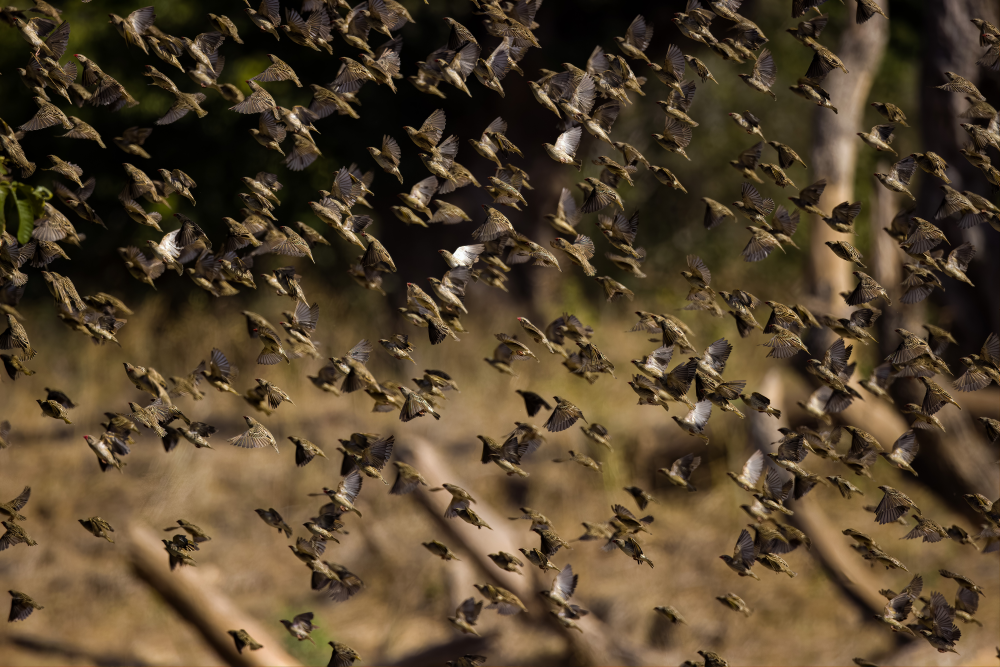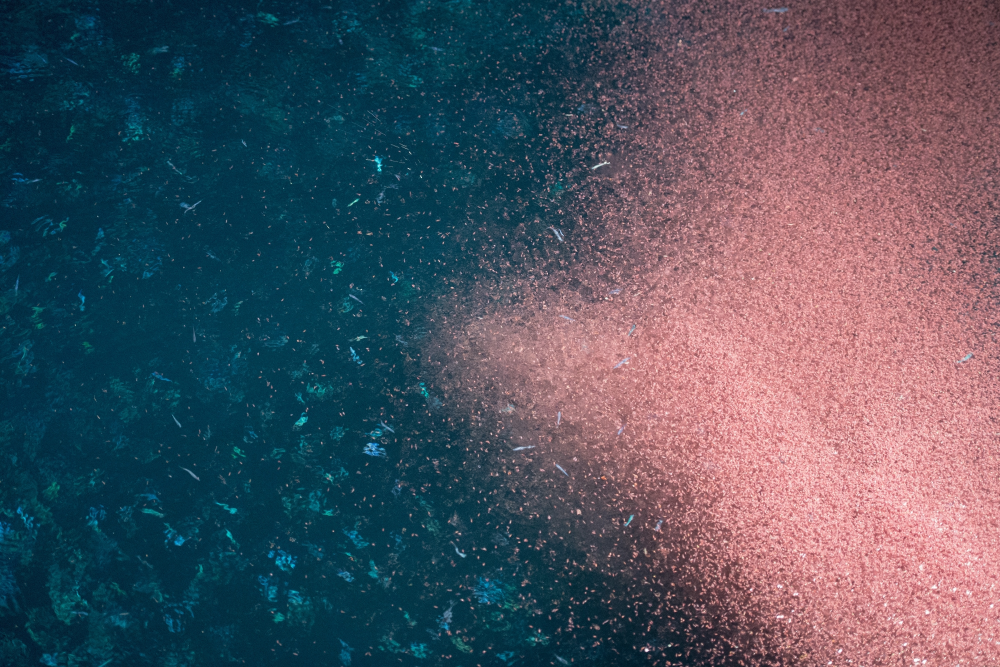Across the globe great animal gatherings are taking place that make the footfall at a Taylor Swift concert look like a kid’s party. The motivations driving these mass gatherings can be the need to flee, feed, or… reproduce, and while the gatherings can be crucial for the survival of a species, there are some examples that are devastating for humans and the environment.
So, who’s hosting the biggest animal party of all? It depends on if you like your guests beefy, or numerous.
The biggest animal gathering on land
One of the most massive animal migrations by weight thunders across the Serengeti each year as over 2 million wildebeest go in search of greening grasses during the wet season. The “Great Migration”, as it’s known, is one of Africa’s biggest wildlife events and is crucial if the wildebeest are to stay fed and keep their calves alive, something the prowling lions and hyenas don’t make easy. The pursuit of food means they’re joined by other herbivores like antelope and zebras, but as they traverse the landscape and its water, more predators enter the fold, like crocodiles. As the seasons trail on, the changing environmental conditions eventually bring them back to where their migration began, and it continues year-on-year in a clockwise movement.
It might be one of the heaviest animal gatherings on the planet, but it’s by no means the largest. Even within the mammals, the herd gets topped by the free-tailed bats, Tadarida brasiliensis, that lurk in caves in colonies 15-million-strong. These migratory animals spend the winter in caves, but come February it’s time to head to Texas where they’ll form large maternity colonies for raising pups. An impressive flight for these bats and their fluorescent toes, but there are far larger airborne spectacles.

Red-billed quelea move like a destructive fluttering cloud, feeding on the environment.
Image credit: Saffa Capture / Shutterstock.com
The biggest animal gathering of birds
If you’ve ever seen a murmuration of starlings, you probably won’t be surprised to learn that these birds flock in their millions, but for all their aerial gymnastics, a stubby penguin has them beat for mass gatherings. The chinstrap penguin, Pygoscelis antarctica, flocks in a colony of around 2 million on Zavodovski Island in the South Sandwich Islands. What’s more, they eat possibly the most abundant animal on planet earth by sheer biomass, but we’ll come to that later.
Two million is a lot for breeding penguins, but that volume goes up tenfold when we look at the migration of shearwaters, which sees them travel from New Zealand to Alaska. It represents one of the longest animal migration routes ever recorded and sees around 20 million birds take to the wing.
But hold my beer, says the red-billed quelea.
Queleas flock in several millions, moving across dry scrubland like a fluttering cloud in search of food. It’s well studied because it can be devastating for agriculture, threatening food security in some regions. They exist in massive flocks that take hours to pass overhead but are also thought to be the most abundant bird on Earth with an estimated population of around 1.5 billion, making its annual “early-rains migration” quite the spectacle.
According to ornithologist Noah Strycker, there was once a kind of pigeon that had the passing time of quelea beat by a matter of days. “There are stories of people standing there and watching a single flock of passenger pigeons fly over them for hours or days at a time, which is crazy!” Strycker told Live Science of the passenger pigeon, which is regrettably now extinct.

Krill may be tiny, but they exist in such huge numbers they can feed some of the planet’s biggest animals.
Image credit: Andrea Izzotti
The biggest animal gathering in the ocean
As migrations go, few are so festive as that of the red crabs on Christmas Island. From October through to January, red crabs (Gecarcoidea natalis) up sticks from their forest home and head for the ocean. Up to 50 million crabs will scuttle across the island, which has had to build special crab highways and bridges to keep them clear of cars. There can be as many as 100 crabs per square meter when spawning night comes as the females congregate on the shore, getting ready to ditch their eggs.
Those numbers are blown out of the water as we head further into the ocean, where herring school in giant, farting balls 4 billion strong. We say farting because the sound created by air escaping from their swim bladders on mass has, historically, almost caused a diplomatic crisis.
Now it’s time to return to the diet of those chinstraps – and that enormously prolific animal they’re eating? Of course, it’s krill. These tiny crustaceans remarkably make up the diet of some of the planet’s largest animals, including humpback and minke whales. It figures, then, that they hang out in the oceans in swarms that are unfathomably huge.
“Krill often form vast swarms or schools in the Southern Ocean,” explains the Antarctic Fund. “These aggregations can stretch for up to 20 kilometres and can contain over a million tonnes of krill in densities over 10,000 animals in every cubic metre – the largest concentrations of animal life in the world.”
If you’ve been following along our debates about whether the future is eating insects, you’ll know that for some there’s little difference between the arthropods of the ocean and those that scuttle around on land. So, what do the terrestrial folks have to offer for animal gatherings?
The biggest gathering of insects
Leave some dip open for 10 minutes at a picnic and you’ll be visited by suspect number one: ants. These small eusocial insects live in vast colonies across the planet, but there’s one that seems to take the crown, the Argentine ant, Linepithema humile.
The largest known “supercolony” for these ants is so big that it spans three countries, stretching 6,000 kilometers (3,700 miles) across parts of Italy, France, and Spain. It contains hundreds of nests each containing billions of ants, but knowing how many there are in total is nearly impossible. Unless you’re volunteering to count?
The supercolony is thought to be nearing the trillions, which is a figure that gets thrown around for another, and very destructive, massive animal gathering. The swarming behavior of locusts is so infamous they’ve even made it into ancient tales of plagues, a concern that was as true for ancient Egyptians as it is for modern humans.
The biggest in history is rumored to be “Albert’s Swarm”, which was recorded by Albert Child in 1875. He wrote that it covered an area the size of California, a quarter-mile deep, in a density that had it been made up of starlings would’ve outweighed the human race twice over. If accurate, it’s thought Albert’s Swarm may have represented trillions of insects, and while the rocky mountain locusts he was studying are now extinct, today’s locusts aren’t making life any easier. They present such a threat to agriculture that scientists are working on ways to identify breeding areas and intercept their eggs, because you’ve got to hand it to the adults, they really know how to throw a party.
Source Link: What’s The Biggest Animal Gathering In The World?